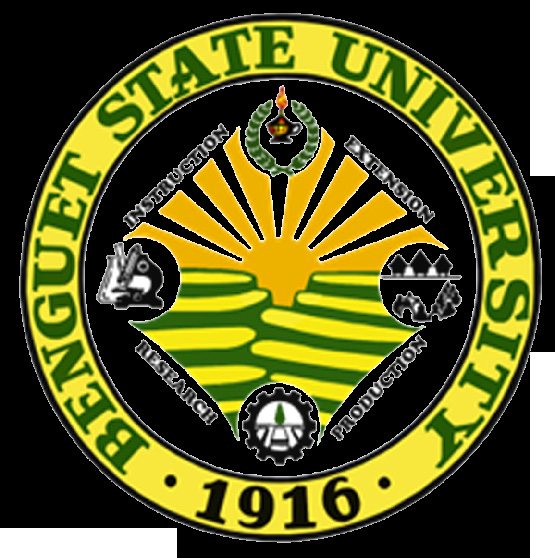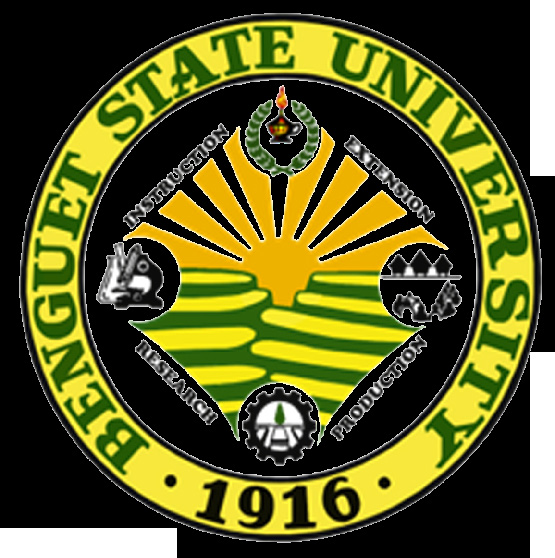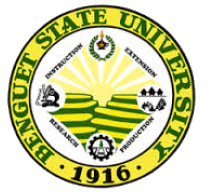Benguet State University RESEARCH JOURNAL ISSN 0117-5297 ...

Benguet State University
RESEARCH JOURNAL
ISSN 0117-5297 No. 72
July-December 2014
TABLE OF CONTENTS
CARBON STOCKED AND CARBON DIOXIDE SEQUESTERED
BY EIGHT -YEAR ALNUS (Alnus japonica)............................................................................... 1-13
L. C. Paran and J. G. Tacloy
PERFORMANCE OF NEW SWEETPOTATO ENTRIES UNDER
LA TRINIDAD, BENGUET CONDITIONS................................................................................. 14-21
I. C. Gonzales, E. T. Botangen and D. K. Simongo
SWEETPOTATO PRODUCT DEVELOPMENT:
MODIFIED YOGHURT, HOPIA AND VINEGAR...................................................................... 22-31
E. T. Botangen, J. K. Mama-o and I. C. Gonzales
WEAVING FOR LIFE: DESIGNS AND MOTIFS
IN THE INABEL OF BONTOC WEAVER
RESPONDENTS IN BAGUIO CITY......................................................................................... 32-38
R. S. Batani
CORRELATION OF THE HIGH SCHOOL AVERAGE GRADE, COLLEGE
ACADEMIC PERFORMACE, AND CLINICAL PERFORMANCE
OF BSU BSN BATCH 2012......................................................................................................... 39-46
V. G. Panagan, Jr., A. M. Na-oy, A. J. D. Napeek,
D. B. Orias, W. B. Padawil
All communications should be addressed to:
THE EDITOR
BSU Research Journal
Benguet State Univeristy
La Trinidad, Benguet 2601, Philippines
Telefax:( +6374) 422-5547
Email address: bsupublications@gmail.com or
repo@bsu.edu.ph
Website: www.bsu.edu.ph

Benguet State University
RESEARCH JOURNAL
This multidisciplinary scientific journal publishes selected
papers but not limited to those presented during the
annual Benguet State University Agency In-House Review
(Agriculture, Forestry and Natural Resources, Social and
Education Sectors).
Editorial Board
Editor-in-Chief
Bernard S. Tad-awan, PhD
College of Agriculture
Technical Editors
Percival B. Alipit, PhD
Betty T. Gayao, Science Research Specialist
Aurea Marie Sandoval, PhD
Editorial Consultants
Luciana M. Villanueva, PhD
Vice President for Research and Extension
Ben D. Ladilad, PhD, CESO III
University President
Referees
Camilo B. Alumit
Jimmy B. Fong, PhD
Cecilia A. Mercado, PhD
Lorenza G. Lirio, PhD
Teresita K. Mangili, PhD
Editorial Staff
Lay-out Artist
Marie Fe B. Wance
Publication Office
Circulation Manager
Jenina P. Balatong
Publication Office
Proofreaders
Jenina P. Balatong
Herman B. Danis
Office of the Vice President for Research and Extension
Publication Office
This is a refereed Journal
Benguet State University Research Journal (BRJ) July-December 2014, 72: 1-13
Copyright 2014, Benguet State University
CARBON STOCKED AND CARBON DIOXIDE SEQUESTERED
BY EIGHT-YR ALNUS (Alnus japonica)
Lanie C. Paran and John G. Tacloy
College of Forestry
Benguet State University
ABSTRACT
The amount of carbon stocked and carbon dioxide sequestered by eight-year old
Alnus trees were estimated using a destructive sampling method. The carbon contents were
computed using the published average values for tropical trees which is 45% – 50%
of dry matter and the CO sequestered was computed based on the published CO to C
2
2
ratio which is 3.6663. The research was conducted in May 2012 at an Alnus stand at the
BSU-College of Forestry, La Trinidad, Benguet.
The average above-ground biomass (AGB) and below-ground biomass (BGB) of
the Alnus trees was 140.99 kg per tree, and their average oven-dry weight was 70.91kg
per tree. The AGB was 71.56%, and the BGB was 28.44% of the total biomass. The
computed biomass of the Alnus trees using a published formula is much lower; their
average AGB is 24.665%, their BGB is 12.58%, and their total computed biomass is
21.18% of the actual biomass.
Based on the oven-dried weight data, the computed average carbon contents of the
Alnus trees was 31.91kg per tree, and the average carbon dioxide they sequestered was
116.999kg per tree in eight-years, or an average of 14.63kg per tree per year.
Base on the findings, Alnus trees can approximate or exceed the published average
CO sequestration rate for mature trees which is 48lb per year. Further, a hectare Alnus
2
plantation with an average of 2m x 2m spacing cansequester about 292.6 tons of CO2
in eight years, or an average of 36.575 tons of CO per year which is equivalent to the
2
CO emissions of about 16 persons.
2
Keywords: Carbon stock, CO sequestration, above-ground and below-ground biomass,
2
artificial Alnus stand
Benguet State University Research Journal (BRJ) July-December 2014, 72: 14-31
Copyright 2014, Benguet State University
PERFORMANCE OF NEW SWEETPOTATO ENTRIES UNDER
LA TRINIDAD, BENGUET CONDITIONS
Ines C. Gonzales, Esther T. Botangen and Donita K. Simongo
NPRCRTC
Benguet State University
ABSTRACT
Twelve sweet potato entries namely; J06-11-10, JK 18-4, JK 7-4, JK 23-1, J06-30-3,
JK 06-11-12, SG 02-07-05, SG 02-05-01, SG 02-05-01, SG 98-16-02, SG 03-09-01,
SG 02-06-02, SG 02-13-02 and two (2) check varieties NSIC 30 and NSIC 31 were
evaluated for its yield performance and acceptability under La Trinidad conditions for
dry and wet season trials from 2009-2011.
Results showed that SG 02-07-05, SG 98-16-02, J06-11-10 had the highest yield
with 24.18 t ha-1, 22.39 t ha-1 and 20.04 t ha-1 respectively. SG 02-07-05 significantly
outyielded the check variety NSIC 31. Based on the sensory evaluation J06-11-
10 was the third top highest yielder. SG 02-05-01, JK 18-4, JK 7-4, SG 02-06-02,
JK 23-1, J06-30-3, SG 02-13-02, (NSIC 20 as check variety) were found highly
acceptable with rating of 7-like very much. The highest dry matter content of
35% was recorded by JK 18-4 and JK 23-1. Most entries are ridgedly deformed.
Keywords: camote, natural saver, famine crop, acceptability
Benguet State University Research Journal (BRJ) July-December 2014, 72: 22-31
Copyright 2014, Benguet State University
SWEETPOTATO PRODUCT DEVELOPMENT: MODIFIED
YOGHURT, HOPIA AND VINEGAR
Esther T. Botangen, Joyce K. Mama-o and Ines C. Gonzales
NPRCRTC
Benguet State University
ABSTRACT
Three sweetpotato entries namely JO6 30-3 (yellow colored flesh), Immitlog (orange
colored flesh) and Haponita (violet colored flesh) were evaluated for their acceptability
when added to yoghurt as flavoring hopia as filling and vinegar as fermenting material.
The product development was done from October 2010 to July 2013.The varieties were
found to be acceptable for the production of yoghurt, hopia and vinegar. Yoghurt and
hopia has good taste, sugar just right and texture is smooth for yoghurt. Sweetpotato
yoghurt can have a shelf-life of one month under refrigerated condition, hopia for seven
days under room temperature conditions ranging from 24 – 26 °C and relative humidity
from 70-80%.
Vinegar is acceptable at six months but has a better taste when aged longer, one year
or more with a pH of 3.4. Addition of yellow, orange and violet fleshed sweetpotato
increases energy, carbohydrates, vitamin A and calcium of yoghurt and vitamin A and
calcium of hopia.With an estimated production cost of Php 33.06, Php 25.78, and Php
23.98 for yoghurt, hopia and vinegar, the computed return on cash expense for yoghurt
is 25.52%, 25.10% for hopia and 25.13% for vinegar if the wholesale price is PhP 41.50
(yoghurt), PhP 32.25 (hopia) and Php30 (vinegar).
Keywords: Sweetpotato, processing, development
Benguet State University Research Journal (BRJ) July-December 2014, 72: 32-38
Copyright 2014, Benguet State University
WEAVING FOR LIFE: DESIGNS AND MOTIFS IN THE INABEL OF
BONTOC WEAVER INFORMANTS IN BAGUIO CITY
Ruth S. Batani
College of Arts and Sciences
Benguet State University
ABSTRACT
Weaving and woven products in their present form have taken on
interesting transformations over the years. Among indigenous women in the city
of Baguio, weaving has taken on new energies with the invention of designs
and new colors while at the same time retaining the ethnic motif. Using key
informant interviews on Bontoc women weavers, the study draws attention to
the artistic output of the weavers that are responding to identity construction at
the same time satisfying market demands. Findings show that women weavers,
at least in their generation, despite the meaningfulness of traditional designs on
their woven fabrics, have also appropriated new designs and colors as part of
their negotiations in the market. Other institutional market demands have also
influenced the presentation of their woven products. Women weavers were able
to negotiate their ‘ethnic motif’ in the market, while at the same time meeting the
challenges of the exclusivist character of ‘ukay-ukay.’
Keywords: abel or inabel; ethnic motif
INFORMATION FOR CONTRIBUTORS
(Abridged/improved from the editorial policies of the Benguet State University)
1. All manuscripts must be the result of research activities (technical or social) that are relevant to the development
thrust of the University and should not have been published elsewhere.
2. Acceptance of manuscript is on the basis of the review and approval by a corps of technical editors and selected
referees.
3. Original photos should be submitted in PNG or JPEG format with corresponding captions.
4. The manuscript should not exceed 40 pages, typed double spaced in 12-point Times New Roman on one side of
81/2” paper with margins of 3.81 cm on the left and 2.54 cm top, right and bottom and must be submitted in hard
and electronic copy via bsupublications@gmail.com using MS Word Program.
5. The manuscript should be organized in the following order: (a) Title; (b) Authors/s; (c) Authors/s position;
(d) Abstract; (e) Introduction; (f) Materials and Methods; (g) Results and Discussion; (h) Conclusions and
Recommendations; (i) Acknowledgment, optional; and (j) Literature Cited ; and written all centered.
6. The title should be a precise and concise description of the contents of the manuscripts without abbreviations and
typed in upper case. If the paper is a portion of a larger manuscript, which shall be serialized and will be indicated
in a superscript followed by a brief explanation.
7. The author(s) name(s) is/are written in this way: initial letter for the middle names only, first and family names in
full and typed in title case. Senior author comes first in case of more than one author.
8. The abstract must be 200 words or less, summarizing the main points of the articles.
9. The introduction should contain scope and statement of the problem, brief survey of previous work and objectives
and importance of the study.
10. Citations in the text follows the name and year system, e. g.
Single Author:
(Adeyemo, 2010), Yeo (2009) or Boquiren (n.d.)
Two Authors:
Pladio and Villasenor (2004), (Pladio and Villasenor, 2004)
More than Two Authors:
Folbre et al. (2011) or (Folbre et al., 2011).
11. Materials and methods should describe very concisely but comprehensively the materials used, techniques, and
lay-out of the research.
12. Scientific names and other foreign expressions such as in situ, et al., i.e., and other similar expressions are italicized.
Technical terms, abbreviations and acronyms must be defined.
13. In abbreviating or using acronyms, the System International-Units (SI) of the metric system should be followed.
Such abbreviations or acronyms should be written first in full before the truncated terms in parenthesis, e.g. thin-
layer chromatography (TLC). If this information is given in the abstract, it should be re-identified when mentioned
the first time.
14. The results should be presented logically and in objective way and conclusions stated as valid facts.
15. The discussion of results should lead to interpreting significance and /or possible similarity or discrepancy from
previous findings.
16. A statement on conflict of interest should be declared by authors before the Acknowledgment section. Where
appropriate, Conflict of Interest statements may be in instances such as:” There are no known conflicts interests
associated with the publication” or “There has been no significant financial support for the work that could have
influenced its outcome.” Whenever appropriate, acknowledgements are made relevant for contributions in terms
of financial and technical support.
17. Literature cited in the text should be indicated as follows: Consolacion (2000) or (Consolacion, 2000); for two
authors, Colting and Maddul (1999) or (Colting and Maddul, 1999); for more than two authors, Bucu et al. (1999)
or (Bucu et al., 1999).
18. Electronic sources must be cited as follows: author (s), year, title, date of retrieval and the complete Uniform
Resource Locator (URL) of the site.
19. Listing of literature cited is by author(s) in alphabetical order. The list contains: author (s), year, title of literature,
publisher, address of publisher, volume and issue numbers and inclusive pages (printed as 1(2):1-9). Names of
authors are typed in upper case: for single author, surname (separated by a comma) first before the initials of the
given and middle names; for multiple authors, surname then initials of senior author followed by initials then
surnames of succeeding authors. Authors are separated by commas.
Single author:
Mondejar, L.A. 1998. Understanding Student Judgments of Teaching Performance: A Conjoint Approach.
Unpublished Doctoral Dissertation, University of the Philippines. Diliman. Quezon City.
Durano, M. 2008. From profit to provisioning: A gender equitable public policy. Development Alternatives
with Women for a New Era. QC: Miriam College.
Eriksen, T. 2001. Small Places, Large Issues. An introduction to Social and Cultural Anthropology. 2nd ed.
London: Pluto Press.
Two authors:
Hallauer, A. R. and F. O. Miranda. 1980. Quantitative Genetics in Maize Breeding. Iowa State University
Press. Ames, Iowa. Pp. 49-52.
Carrasco, C. and M. Serrano. 2011. Lights and Shadows of Household Satellite Accounts: The Case of
Catalonia, Spain. Feminist Economics 17 (2): 68-85. IAFFE: Routledge Taylor and Francis Group.
Crisologo, L. C. and L. Berlage. 2006. Bargaining in rural households: a study of decision on labor market
participation in the Cordillera. The Philippine Review of Economics. 48 (2): 249- 537.
More than two authors:
Linsley, R., J. Franzini, D. Freyburg and G. Tchobanoglous. 1992. Water Resources Engineering. 4th ed.
McGraw-Hill, Inc. New Jersey, USA.Pp. 510-532.
Aguilar, N. O., B. L. Cardenas and M. A. O. Cajano. 2000. Spore and Seed bearing Plants of Mount Pulag,
Benguet, Philippines. Museum of Natural History. UPLB, College, Laguna, Philippines.
Braunstein, E. B., I. P. Van Staveren and D. Tavani. 2011. Embeding care and unpaid work in Macroeconomic
Modelling. A structural Approach. Feminist Economics. 17, 4-31.
20. If necessary, protocols for manuscript preparation can be requested from the Editorial Board.
21. Please see the latest issue of the Journal for concrete details as to format.

BSU Research Journal No. 75
BSU Research Journal No. 75
VISION
A premier State University in Asia.
MISSION
Development of people imbued with academic excellence, social conscience and productivity; and
actively generating and promoting environment-friendly, useful technologies to improve quality of life.
GOALS
1. Strengthen and sustain a working environment conducive for excellence;
2. Provide quality education that will produce globally competitive and well-rounded graduates;
3. Provide quality and client-responsive research and extension services;
4. Strengthen and enhance institutional capability in generating revenue towards self-reliance
5. Develop and strengthen quality management system towards economy; and
6. Strengthen and expand private public partnership.
PURPOSE
* To provide quality education that will produce globally-competitive graduates;
* To generate and disseminate appropriate knowledge and technologies that will promote sustainable
resource development;
* To strengthen and enhance institutional capability in generating revenue towards self-reliance;
* To establish competent and effective services geared towards efficiency and economy; and
* To develop harmonious and cooperative University Community relationships.
Benguet State University
RESEARCH JOURNAL
All communications should be addressed to:
THE EDITOR
BSU Research Journal
Benguet State University
La Trinidad 2601 Benguet, Philippines
Telefax: (+6374) 422-5547
Email address: bsupublications@gmail.com
Website: www.bsu.edu.ph
11 11